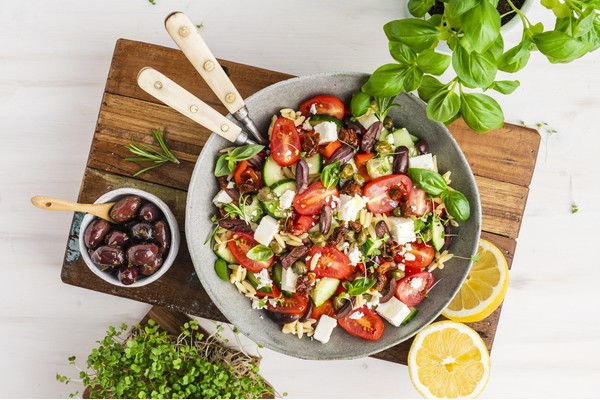From the olive on the tree to the finished olive oil in the bottle, it's a long journey that is full of fruitiness. Anyone interested in olive oil production should definitely try making their own olive oil. It's a special experience that is guaranteed to be impressive and delicious.
DIY: Olive Oil Production
When producing outstanding homemade olive oil, it is important to use high-quality organic olives. The freshest harvested olives undoubtedly yield the most flavorful and nutrient-rich results. However, since olive trees are mainly found in Mediterranean regions, marinated organic olives are an excellent alternative.
What is needed?
For beginners making their own olive oil for the first time, one kilogram of olives is sufficient. Both green and black olives are suitable.
Furthermore, some tools are required, most of which can be found in almost any kitchen:
- 2 x pot/bowl
- sturdy kitchen sieve
- cotton or linen cheesecloth
- tablespoon for skimming
- pestle/blender
Tip: If using olives with pits, it is advisable to use a large, solid pestle or wooden club to crush them as much as possible. This is because it's worth crushing the nutrient-rich pits. For pitted olives, a blender is a more convenient option as it requires less force.
Step-by-step instructions
Here's how to make olive oil in a particularly gentle manner:
- Start by thoroughly washing the olives. Optionally, the pits can be removed. While valuable nutrients may be lost in the process, using a blender is comparatively less strenuous.
- Crush the olives, along with the pits, in a pot or bowl using the pestle. Blender alternative: Blend pitted olives into a paste-like consistency.
- Press the olive pulp through the (coarse) kitchen sieve, collecting the liquid in another bowl. Then wrap the olive mash in the cheesecloth and squeeze it vigorously to extract the remaining liquid.
- Allow the collected mixture of water and olive oil to stand covered for approximately 12 to 24 hours, allowing the water and oil to separate.
- Skim off the olive oil floating on top using a tablespoon and collect it in a bottle or screw-top jar.
- Done! The homemade olive oil can now be consumed fresh or used for cooking and baking.
Tip: When storing the oil, it is important to keep it cool and dark.
How many olives for 1 liter of olive oil?
Depending on the variety and ripeness, olives have an oil content ranging from 10 to 35 percent. Furthermore, black olives, due to their longer ripening period, are particularly productive in terms of olive oil yield.
On average, approximately 8 kilograms of olives are needed to produce one liter of olive oil, which is equivalent to about 2000 to 4000 olives. However, for homemade olive oil in your own kitchen, it is advisable to calculate a bit more generously. Manual production on a small scale is expected to result in a slightly lower yield.
Olive Oil Production at MANI
Compared to making olive oil at home, the production process at MANI, in the Greek region of Mani, naturally takes place on a much larger scale. However, the entire process is carried out without the use of chemical additives and with great enthusiasm for the craft.

Make your own olive oil stands for fun and a delicious result.
The freshly harvested olives are first washed and immediately processed in the local olive mills. After crushing them, the gentle cold extraction takes place in a centrifuge. This process separates the liquid from the pulp. Subsequently, another centrifugation is performed to separate the oil from the fruit water.
Quote from Felix Bläuel: "For the olive oil quality, it is important that the olives are already good on the tree and then pressed quickly. [...] When you see the result as the oil flows out. That's something very special." Just to experience this extraordinary sensation, it is worth making your own olive oil.
Recipes with Homemade Olive Oil
When making olive oil yourself, there will always be some solid residue (olive pomace) and the "juice" from the pulp remaining. Both can be further processed in a delicious way to make use of all the valuable components of the precious fruit.
For example, you can use the olive pomace, together with the homemade olive oil and some olives, to make a savory focaccia. Additionally, the juice can be used to create a particularly intense salad dressing.
On the other hand, if you can't wait to taste your first homemade olive oil, simply drizzle some on fresh white bread with a pinch of salt, and you'll have a delicious appetizer ready in no time.

















